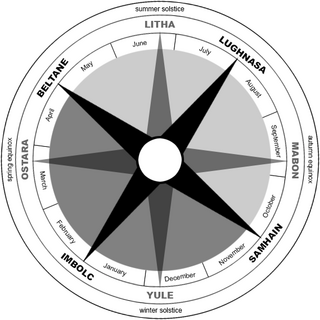An esbat is a coven meeting or ritual at a time other than one of the Sabbats within Wicca and other Wiccan-influenced forms of contemporary Paganism.

Gardnerian Wicca, or Gardnerian witchcraft, is a tradition in the neopagan religion of Wicca, whose members can trace initiatory descent from Gerald Gardner. The tradition is itself named after Gardner (1884–1964), a British civil servant and amateur scholar of magic. The term "Gardnerian" was probably coined by the founder of Cochranian Witchcraft, Robert Cochrane in the 1950s or 1960s, who himself left that tradition to found his own.

Wicca, also known as "The Craft", is a modern pagan, syncretic, earth-centered religion. Considered a new religious movement by scholars of religion, the path evolved from Western esotericism, developed in England during the first half of the 20th century, and was introduced to the public in 1954 by Gerald Gardner, a retired British civil servant. Wicca draws upon ancient pagan and 20th-century hermetic motifs for theological and ritual purposes. Doreen Valiente joined Gardner in the 1950s, further building Wicca's liturgical tradition of beliefs, principles, and practices, disseminated through published books as well as secret written and oral teachings passed along to initiates.

The Wheel of the Year is an annual cycle of seasonal festivals, observed by a range of modern pagans, marking the year's chief solar events and the midpoints between them. Modern pagan observances are based to varying degrees on folk traditions, regardless of the historical practices of world civilizations. British neopagans popularized the Wheel of the Year in the mid-20th century, combining the four solar events marked by many European peoples, with the four midpoint festivals celebrated by Insular Celtic peoples.

An athame or athamé is a ceremonial blade, generally with a black handle. It is the main ritual implement or magical tool among several used in ceremonial magic traditions, and by other neopagans, witchcraft, as well as satanic traditions. A black-handled knife called an arthame appears in certain versions of the Key of Solomon, a grimoire dating to the Renaissance.

A Book of Shadows is a book containing religious text and instructions for magical rituals found within the Neopagan religion of Wicca. Since its conception, it has made its way into many pagan practices and paths. The most famous Book of Shadows was created by the pioneering Wiccan Gerald Gardner sometime in the late 1940s or early 1950s, and which he utilised first in his Bricket Wood coven and then in other covens which he founded in following decades. The Book of Shadows is also used by other Wiccan traditions, such as Alexandrian Wicca and Mohsianism, and with the rise of books teaching people how to begin following non-initiatory Wicca in the 1970s onward, the idea of the Book of Shadows was then further propagated amongst solitary practitioners unconnected to earlier, initiatory traditions.
Alexandrian Wicca or Alexandrian Witchcraft is a tradition of the Neopagan religion of Wicca, founded by Alex Sanders who, with his wife Maxine Sanders, established the tradition in the United Kingdom in the 1960s. Alexandrian Wicca is similar in many ways to Gardnerian Wicca, and receives regular mention in books on Wicca as one of the religion's most widely recognised traditions.
Stregheria is a neo-pagan tradition similar to Wicca, with Italian and Italian American origins. While most practitioners consider Stregheria to be a distinct tradition from Wicca, some academics consider it to be a form of Wicca or an offshoot. Both have similar beliefs and practices. For example, Stregheria honors a pantheon centered on a Moon Goddess and a Horned God, similar to Wiccan views of divinity.

Scott Douglas Cunningham was an American writer. Cunningham is the author of several books on Wicca and various other alternative religious subjects.

A magic circle is a circle of space marked out by practitioners of some branches of ritual magic, which they generally believe will contain energy and form a sacred space, or will provide them a form of magical protection, or both. It may be marked physically, drawn in a material like salt, flour, or chalk, or merely visualised.
Raymond Buckland, whose craft name was Robat, was an English writer on the subject of Wicca and the occult, and a significant figure in the history of Wicca, of which he was a high priest in both the Gardnerian and Seax-Wica traditions.
A covenstead is a meeting place of a coven. The term relates specifically to the meeting place of witches within certain modern religious movements such as Wicca that fall under the collective term Modern Paganism, also referred to as Contemporary Paganism or Neopaganism. It functions to provide a place for the group to conduct rituals, undertake lessons and recognise festivals. It can also be referred to as the home of the coven.

Blue Star Wicca is one of a number of Wiccan traditions, and was created in the United States in the 1970s based loosely on the Gardnerian and Alexandrian traditions.
Drawing down the Moon is a central ritual in many contemporary Wiccan traditions. During the ritual, a coven's High Priestess enters a trance and requests that the Goddess or Triple Goddess, symbolized by the Moon, enter her body and speak through her. The High Priestess may be aided by the High Priest, who invokes the spirit of the Goddess. During her trance, the Goddess is supposed to speak through the High Priestess.
A solitary witch is one who chooses to practice their spiritual faith in the privacy of their home or other designated space, without the need to participate in a group such as that of a Wiccan coven; although it's not uncommon for solitaries to participate in some communal activities. Many solitary practitioners are Neo-pagans, who adhere to a diverse group of pagan religions that include various forms of Wicca, Traditional Reconstructionism and Traditional British Witchcraft, among others. About half of all pagans are self-ascribed solitary practitioners.
A watchtower or guardian in ceremonial magical tradition is a tutelary spirit of one of the four cardinal points or quarters. In many magical traditions, they are understood to be Enochian angels or the Archangels Uriel, Raphael, Michael, and Gabriel. They are also variously associated in other traditions with each of the four classical elements or stars. Originating with the Enochian tradition of John Dee, a version of it was popularized by the Hermetic Order of the Golden Dawn, which became hugely influential in modern Western Esotericism, including Wicca. The watchtowers are invoked during the ritual of casting a magic circle.
The history of Wicca documents the rise of the Neopagan religion of Wicca and related witchcraft-based Neopagan religions. Wicca originated in the early 20th century, when it developed amongst secretive covens in England who were basing their religious beliefs and practices upon what they read of the historical witch-cult in the works of such writers as Margaret Murray. It was subsequently founded in the 1950s by Gardner, who claimed to have been initiated into the Craft – as Wicca is often known – by the New Forest coven in 1939. Gardner's form of Wicca, the Gardnerian tradition, was spread by both him and his followers like the High Priestesses Doreen Valiente, Patricia Crowther and Eleanor Bone into other parts of the British Isles, and also into other, predominantly English-speaking, countries across the world. In the 1960s, new figures arose in Britain who popularized their own forms of the religion, including Robert Cochrane, Sybil Leek and Alex Sanders, and organizations began to be formed to propagate it, such as the Witchcraft Research Association. It was during this decade that the faith was transported to the United States, where it was further adapted into new traditions such as Feri, 1734 and Dianic Wicca in the ensuing decades, and where organizations such as the Covenant of the Goddess were formed.

Wiccan views of divinity are generally theistic, and revolve around a Goddess and a Horned God, thereby being generally dualistic. In traditional Wicca, as expressed in the writings of Gerald Gardner and Doreen Valiente, the emphasis is on the theme of divine gender polarity, and the God and Goddess are regarded as equal and opposite divine cosmic forces. In some newer forms of Wicca, such as feminist or Dianic Wicca, the Goddess is given primacy or even exclusivity. In some forms of traditional witchcraft that share a similar duotheistic theology, the Horned God is given precedence over the Goddess.

In the neopagan religion of Wicca a range of magical tools are used in ritual practice. Each of these tools has different uses and associations and are commonly used at an altar, inside a magic circle.
Cochrane's Craft, also known as Cochranianism and The Clan of Tubal Cain, is a religious movement similar to Wicca that considers itself a form of Traditional Witchcraft. It was founded in 1951 by the English witch Robert Cochrane, who himself claimed to have been taught in the tradition by some of his elderly family members, a claim that is disputed by historians such as Ronald Hutton and Leo Ruickbie.











